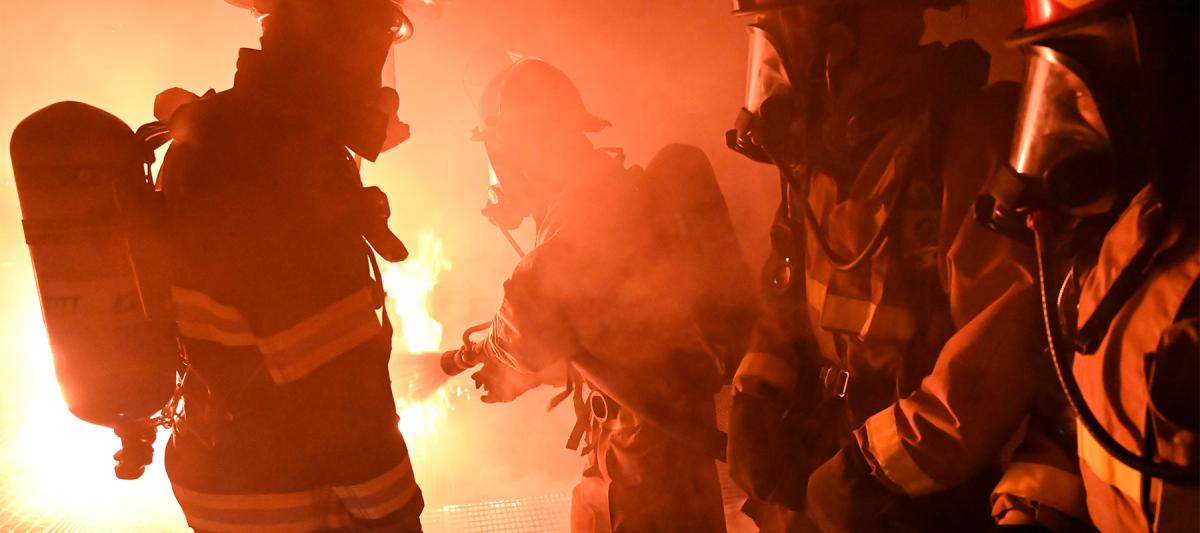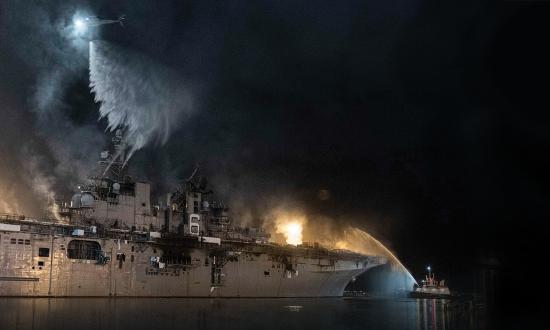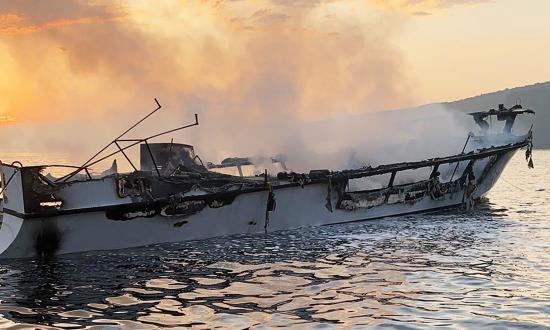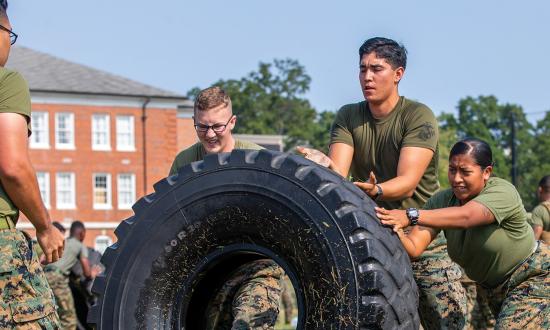A large proportion of today’s sailors are in suboptimal shape, with one study finding 22 percent are obese, the highest rate among the branches. While the Navy has many programs to enhance physical fitness, few focus on addressing actual occupational demands, which presents real-world operational performance concerns.
The standard Physical Fitness Assessment (PFA) primarily evaluates general fitness through pushups, planks, and a cardiorespiratory endurance test (e.g., a run, swim, or stationary bike test). While adequate for assessing general fitness, this type of test does not directly assess an afloat sailor’s physical ability to perform one of his or her most critical and physically demanding duties: firefighting. Just like every Marine is rifleman, every afloat sailor is firefighter.
Firefighting is a highly demanding activity that requires a distinct set of physical capabilities, including:
Strength and Power. Firefighters must be able to lift and carry heavy equipment/hoses, perform forcible entry, and move casualties. The PFA does not adequately measure the upper and lower body strength and power critical for these tasks.
Endurance and Stamina. Firefighting operations can be prolonged and strenuous. While the cardiorespiratory component of the PFA assesses general endurance, it does not replicate the sustained physical exertion required in firefighting, which involves wearing heavy protective gear and working in extreme conditions.
Agility and Flexibility. Firefighters need to move quickly and efficiently in confined and unpredictable environments. The PFA does currently not evaluate agility or flexibility, which are essential for navigating tight spaces.
Heat and Stress Tolerance. Firefighting involves working in high-temperatures and under significant psychological stress. The PFA does not measure one’s ability to perform under these specific conditions.
All told, the PFA does not properly assesses a sailor’s physical readiness to effectively fight major shipboard fires, especially in a wartime scenario. No matter the rating, all sailors should be trained and assessed to fulfill the physical demands specific to firefighting. There is a strong precedent for this approach, as civilian firefighters are required to complete an occupational specific assessment annually to ensure they can effectively fulfill their duties. While the assessments vary by organization, they generally include stair climbing, hose dragging, equipment carrying, ladder raising, forcible entry, and a body rescue drag. These events are completed in a continuous and timed manner, with participants wearing a 50-pound vest throughout the assessment to simulate the weight of firefighter equipment (some agencies require wearing the standard kit during the assessment), and an additional 25 pounds added during the stairclimbing event.
To address the PFA’s shortcomings, afloat commands need a firefighting-centric human performance optimization program that incorporates strength training, cardiovascular conditioning, flexibility exercises, and stress management strategies that help sailors meet the rigorous demands associated with firefighting and equivalent emergency response scenarios.
Physical Fitness and Readiness. Firefighting is physically demanding and requires strength, endurance, and agility. Human performance optimization programs help develop these physical attributes through targeted training regimens. Strength training is essential for lifting heavy equipment, agility for maneuvering in confined spaces, and cardiovascular conditioning for sustaining prolonged firefighting operations. Flexibility exercises are also crucial to prevent injuries and improve mobility. By focusing on these aspects, sailors would be better physically prepared to tackle the challenges of firefighting.
Mental Resilience and Decision-Making. The ability to adapt to change and uncertainty is critical to staying calm under stressful conditions and making good decisions. Human performance optimization programs address this by incorporating stress inoculation techniques, cognitive training, and decision-making exercises. These elements help sailors maintain composure under pressure, think clearly in high-stress environments, and make rapid, informed decisions during firefighting operations. By enhancing mental resilience premised on firefighting demands, such programs equip sailors with the psychological tools necessary to handle the intense demands of firefighting and reduce the risk of panic or indecision in emergency situations.
Occupational Health and Injury Prevention. Firefighting poses significant risks of injury, including burns, smoke inhalation, and musculoskeletal injuries. Human performance optimization programs play a crucial role in injury prevention by emphasizing proper techniques, safety protocols, and equipment handling. These programs also promote recovery and rehabilitation strategies to ensure sailors can return to duty safely and effectively after an injury. By prioritizing occupational health and safety, human performance optimization programs minimize the risk of injuries and ensure sailors can perform their firefighting duties without compromising their long-term health or the command’s operational effectiveness.
Teamwork and Communication. Effective firefighting requires seamless teamwork and communication. Human performance optimization programs foster these skills by incorporating team-building exercises and communication training into their curriculum. These activities enhance cohesion and trust, enabling sailors to work together efficiently during stressful firefighting operations. By improving teamwork and communication, human performance optimization programs contribute to the overall effectiveness of firefighting teams and ensure that sailors can coordinate their efforts to control fires quickly and safely.
Ultimately, the goal of human performance optimization programs centered around firefighting is the operational readiness and mission success of afloat sailors. Such readiness is crucial for maintaining the safety and security of ships and for protecting the lives of sailors and embarked Marines. The Navy should establish an annual firefighting physical fitness assessment for sailors assigned to afloat commands and those preparing to report to afloat commands. A focused program of this nature would enhance the overall physical fitness, mental resilience, and wellbeing of afloat sailors, enabling them to respond effectively to fire and other damage control emergencies.






